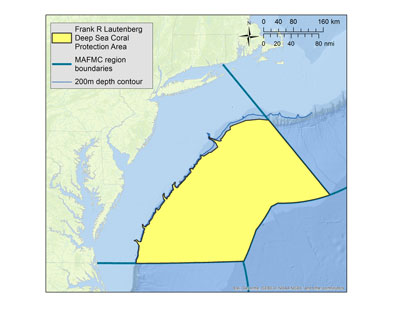
NOAA Fisheries recently published the final rule for a Mid-Atlantic Fishery Management Council (MAFMC) action to designate a large offshore marine protected area for deep sea corals in the Mid-Atlantic.
MAFMC approved the Deep Sea Corals Amendment to the Mackerel, Squid, Butterfish Fishery Management Plan in 2015 in order to protect deep sea corals from the impacts of bottom-tending fishing gear.
This final rule designates a large “deep sea coral zone” in areas where corals have been observed or where they are likely to occur.
Under the Magnuson-Stevens Act (MSA), regional fishery management councils have the discretionary authority to designate zones where fishing may be restricted to protect deep sea corals.
The Mid-Atlantic Fishery Management Council is the first of the eight U.S. regional fishery management councils to use this discretionary authority.
The Frank R. Lautenberg Deep Sea Coral Protection Area encompasses areas of known or highly likely coral presence in underwater canyons or slope areas along the continental shelf edge, as well as deeper areas where the presence of corals is uncertain, but where little or no fishing effort currently occurs.
In total, the coral zone encompasses more than 38,000 square miles of federal waters off the Mid-Atlantic coast, an area approximately the size of the state of Virginia.
Within the protected area, commercial fishermen are prohibited from using most types of bottom-tending fishing gear such as trawls, dredges, bottom longlines, and traps.
The rule does not apply to recreational fishing, commercial gear types that do not contact the sea floor, or the American lobster trap fishery.
An exemption is provided for the deep sea red crab commercial trap fishery. Vessels may transit through the area if fishing gear is stowed and not available for immediate use.
source: Mid-Atlantic Fishery Management Council